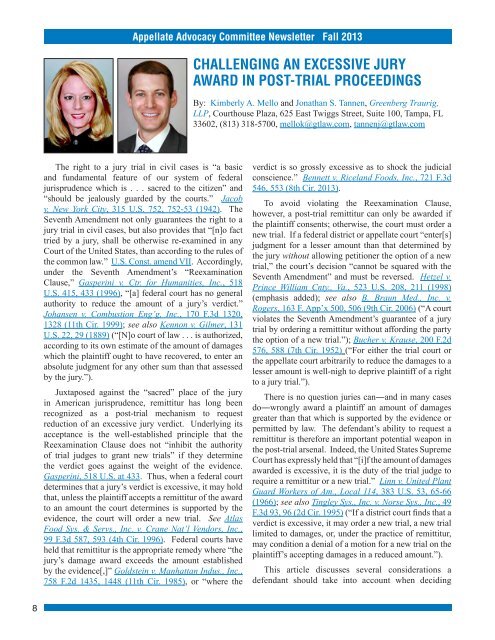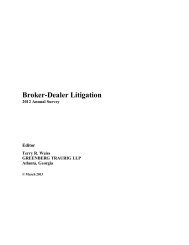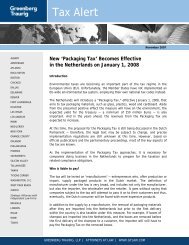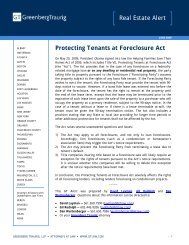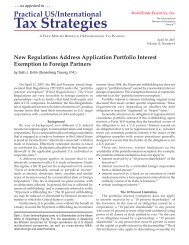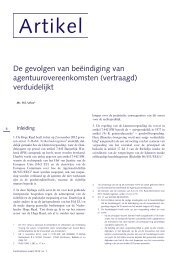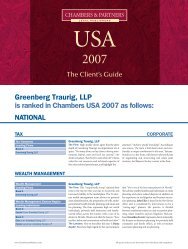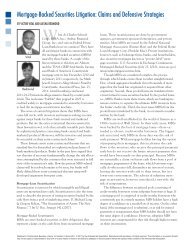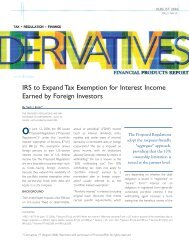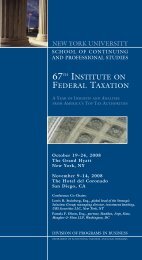Appellate Advocacy Fall 2013 Newsletter No Reg - Greenberg ...
Appellate Advocacy Fall 2013 Newsletter No Reg - Greenberg ...
Appellate Advocacy Fall 2013 Newsletter No Reg - Greenberg ...
You also want an ePaper? Increase the reach of your titles
YUMPU automatically turns print PDFs into web optimized ePapers that Google loves.
<strong>Appellate</strong> <strong>Advocacy</strong> Committee <strong>Newsletter</strong> <strong>Fall</strong> <strong>2013</strong><br />
CHALLENGING AN EXCESSIVE JURY<br />
AWARD IN POST-TRIAL PROCEEDINGS<br />
By: Kimberly A. Mello and Jonathan S. Tannen, <strong>Greenberg</strong> Traurig,<br />
LLP, Courthouse Plaza, 625 East Twiggs Street, Suite 100, Tampa, FL<br />
33602, (813) 318-5700, mellok@gtlaw.com, tannenj@gtlaw.com<br />
The right to a jury trial in civil cases is “a basic<br />
and fundamental feature of our system of federal<br />
jurisprudence which is . . . sacred to the citizen” and<br />
“should be jealously guarded by the courts.” Jacob<br />
v. New York City, 315 U.S. 752, 752-53 (1942). The<br />
Seventh Amendment not only guarantees the right to a<br />
jury trial in civil cases, but also provides that “[n]o fact<br />
tried by a jury, shall be otherwise re-examined in any<br />
Court of the United States, than according to the rules of<br />
the common law.” U.S. Const. amend VII. Accordingly,<br />
under the Seventh Amendment’s “Reexamination<br />
Clause,” Gasperini v. Ctr. for Humanities, Inc., 518<br />
U.S. 415, 433 (1996), “[a] federal court has no general<br />
authority to reduce the amount of a jury’s verdict.”<br />
Johansen v. Combustion Eng’g, Inc., 170 F.3d 1320,<br />
1328 (11th Cir. 1999); see also Kennon v. Gilmer, 131<br />
U.S. 22, 29 (1889) (“[N]o court of law . . . is authorized,<br />
according to its own estimate of the amount of damages<br />
which the plaintiff ought to have recovered, to enter an<br />
absolute judgment for any other sum than that assessed<br />
by the jury.”).<br />
Juxtaposed against the “sacred” place of the jury<br />
in American jurisprudence, remittitur has long been<br />
recognized as a post-trial mechanism to request<br />
reduction of an excessive jury verdict. Underlying its<br />
acceptance is the well-established principle that the<br />
Reexamination Clause does not “inhibit the authority<br />
of trial judges to grant new trials” if they determine<br />
the verdict goes against the weight of the evidence.<br />
Gasperini, 518 U.S. at 433. Thus, when a federal court<br />
determines that a jury’s verdict is excessive, it may hold<br />
that, unless the plaintiff accepts a remittitur of the award<br />
to an amount the court determines is supported by the<br />
evidence, the court will order a new trial. See Atlas<br />
Food Sys. & Servs., Inc. v. Crane Nat’l Vendors, Inc.,<br />
99 F.3d 587, 593 (4th Cir. 1996). Federal courts have<br />
held that remittitur is the appropriate remedy where “the<br />
jury’s damage award exceeds the amount established<br />
by the evidence[,]” Goldstein v. Manhattan Indus., Inc.,<br />
758 F.2d 1435, 1448 (11th Cir. 1985), or “where the<br />
verdict is so grossly excessive as to shock the judicial<br />
conscience.” Bennett v. Riceland Foods, Inc., 721 F.3d<br />
546, 553 (8th Cir. <strong>2013</strong>).<br />
To avoid violating the Reexamination Clause,<br />
however, a post-trial remittitur can only be awarded if<br />
the plaintiff consents; otherwise, the court must order a<br />
new trial. If a federal district or appellate court “enter[s]<br />
judgment for a lesser amount than that determined by<br />
the jury without allowing petitioner the option of a new<br />
trial,” the court’s decision “cannot be squared with the<br />
Seventh Amendment” and must be reversed. Hetzel v.<br />
Prince William Cnty., Va., 523 U.S. 208, 211 (1998)<br />
(emphasis added); see also B. Braun Med., Inc. v.<br />
Rogers, 163 F. App’x 500, 506 (9th Cir. 2006) (“A court<br />
violates the Seventh Amendment’s guarantee of a jury<br />
trial by ordering a remittitur without affording the party<br />
the option of a new trial.”); Bucher v. Krause, 200 F.2d<br />
576, 588 (7th Cir. 1952) (“For either the trial court or<br />
the appellate court arbitrarily to reduce the damages to a<br />
lesser amount is well-nigh to deprive plaintiff of a right<br />
to a jury trial.”).<br />
There is no question juries can―and in many cases<br />
do―wrongly award a plaintiff an amount of damages<br />
greater than that which is supported by the evidence or<br />
permitted by law. The defendant’s ability to request a<br />
remittitur is therefore an important potential weapon in<br />
the post-trial arsenal. Indeed, the United States Supreme<br />
Court has expressly held that “[i]f the amount of damages<br />
awarded is excessive, it is the duty of the trial judge to<br />
require a remittitur or a new trial.” Linn v. United Plant<br />
Guard Workers of Am., Local 114, 383 U.S. 53, 65-66<br />
(1966); see also Tingley Sys., Inc. v. <strong>No</strong>rse Sys., Inc., 49<br />
F.3d 93, 96 (2d Cir. 1995) (“If a district court finds that a<br />
verdict is excessive, it may order a new trial, a new trial<br />
limited to damages, or, under the practice of remittitur,<br />
may condition a denial of a motion for a new trial on the<br />
plaintiff’s accepting damages in a reduced amount.”).<br />
This article discusses several considerations a<br />
defendant should take into account when deciding<br />
8 8
<strong>Appellate</strong> <strong>Advocacy</strong> Committee <strong>Newsletter</strong> <strong>Fall</strong> <strong>2013</strong><br />
whether to seek a post-trial remittitur of an excessive<br />
jury verdict. First, under what circumstances must a<br />
plaintiff be given the option of a new trial? Second,<br />
what is the proper procedure for seeking a remittitur?<br />
And third, is there any danger that an even higher<br />
award would be returned if the plaintiff were to elect<br />
a new trial?<br />
When Does the Reexamination Clause Apply?<br />
In deciding whether to challenge an excessive<br />
jury verdict, the first question a party must consider<br />
is whether the jury’s award is excessive as a matter<br />
of fact or law. This distinction is important because<br />
the Supreme Court has held that the Reexamination<br />
Clause is implicated―requiring a federal court to give<br />
the plaintiff the option of a new trial―only when a<br />
reduction in the verdict is based on an issue of fact. See<br />
Cooper Indus., Inc. v. Leatherman Tool Grp., Inc., 532<br />
U.S. 424, 436 (2001). “Neither common law nor the<br />
Seventh Amendment, however, prohibits reexamination<br />
of the verdict for legal error.” Johansen, 170 F.3d at<br />
1330 (emphasis added). “Therefore, if legal error is<br />
detected, the federal courts have the obligation and<br />
the power to correct the error by vacating or reversing<br />
the jury’s verdict.” Id. In addition, “where a portion<br />
of a verdict is for an identifiable amount that is not<br />
permitted by law, the court may simply modify the<br />
jury’s verdict to that extent and enter judgment for the<br />
correct amount. . . . The Seventh Amendment is not<br />
offended by this reduction because the issue is one of<br />
law and not fact.” Id. (citations omitted).<br />
Stated differently, the “critical question” in<br />
determining whether a district court has authority to<br />
order remittitur without affording the plaintiff the option<br />
of a new trial is whether, by granting remittitur, the court<br />
would “‘substitute[] its own evaluation of the evidence<br />
regarding damages for the jury’s factual findings’ or<br />
whether the reduction of damages [would be] based on a<br />
‘determination that the law does not permit the award.’”<br />
Cartel Asset Mgmt. v. Ocwen Fin. Corp., 249 F. App’x<br />
63, 81 (10th Cir. 2007) (quoting Corpus v. Bennett, 430<br />
F.3d 912, 917 (8th Cir. 2005)).<br />
Based on these principles, federal courts have<br />
found that certain damage awards are legally erroneous<br />
and, therefore, that the plaintiff need not be afforded<br />
the option of a new trial. For instance, the Supreme<br />
Court has held that the Reexamination Clause is<br />
not implicated if an award of punitive damages is<br />
constitutionally excessive:<br />
“Unlike the measure of actual damages<br />
suffered, which presents a question of<br />
historical or predictive fact, the level<br />
of punitive damages is not really a<br />
‘fact’ ‘tried’ by the jury.” Because<br />
the jury’s award of punitive damages<br />
does not constitute a finding of “fact,”<br />
appellate review of the district court’s<br />
determination that an award is consistent<br />
with due process does not implicate the<br />
[Reexamination Clause].<br />
Cooper Indus., Inc., 532 U.S. at 437 (citations<br />
omitted). In other words, a constitutional reduction of<br />
an award of punitive damages “is a determination that<br />
the law does not permit the award.” Johansen, 170 F.3d<br />
at 1331.<br />
Courts have also held that a new trial does not need<br />
to be offered if the district court is merely reducing a<br />
“nominal” damages award to a legally nominal amount<br />
where there was a finding by the jury that the plaintiff<br />
suffered no direct injury. See Corpus, 430 F.3d at 915-17<br />
(reducing the jury’s nominal damages award of $75,000<br />
to one dollar). In such a circumstance, the Seventh<br />
Amendment is not implicated because “the district court<br />
did not substitute its own evaluation of the evidence<br />
regarding damages for the jury’s factual findings.<br />
Instead, the district court made ‘a determination that the<br />
law does not permit the award,’ and followed its duty to<br />
reduce the nominal damages award to conform with the<br />
law.” Id. at 917 (internal citation omitted) (quoting Ross<br />
v. Kansas City Power & Light Co., 293 F.3d 1041, 1049<br />
(8th Cir. 2002)).<br />
Similarly, courts have held that the Reexamination<br />
Clause is not implicated where the court reduces a<br />
verdict to comply with a statutory damages cap. See,<br />
e.g., Davis v. Omitowoju, 883 F.2d 1155, 1162 (3d Cir.<br />
1989) (holding that the Reexamination Clause did not<br />
apply to the reduction of a jury award to comply with<br />
a $250,000 statutory cap on non-economic damages<br />
in medical malpractice cases); see also Gasperini,<br />
518 U.S. at 429 n.9 (“While we have not specifically<br />
addressed the issue, courts of appeals have held that<br />
district court application of state statutory caps in<br />
diversity cases, postverdict, does not violate the<br />
Seventh Amendment.”). The reason is that, in the<br />
case of a statutory damages cap, “a court does not<br />
‘reexamine’ a jury’s verdict or impose its own factual<br />
determination regarding what a proper award might<br />
be. Rather, the court simply implements a legislative<br />
9 9
<strong>Appellate</strong> <strong>Advocacy</strong> Committee <strong>Newsletter</strong> <strong>Fall</strong> <strong>2013</strong><br />
policy decision to reduce the amount recoverable to<br />
that which the legislature deems reasonable.” Estate<br />
of Sisk v. Manzanares, 270 F. Supp. 2d 1265, 1278 (D.<br />
Kan. 2003).<br />
Even where a damages award is reduced due to<br />
legal error, however, courts may still elect to offer the<br />
plaintiff the option of a new trial. The Second Circuit,<br />
for example, has continued to require that the plaintiff<br />
be permitted to opt for a new trial when a court reduces<br />
the amount of punitive damages. See Thomas v. iStar<br />
Fin., Inc., 652 F.3d 141, 146-47 (2d Cir. 2010) (noting<br />
that, notwithstanding the Supreme Court’s decision<br />
in Cooper, “the law of this Circuit does not appear to<br />
distinguish between compensatory and punitive damages<br />
. . . even where the punitive damages award has been<br />
held unconstitutionally excessive”). Defendants seeking<br />
a reduction in a jury’s verdict based on legal error should<br />
therefore be aware that, while the Seventh Amendment<br />
may not require courts to offer a plaintiff the option of a<br />
new trial, certain circuits may nonetheless require that the<br />
plaintiff be given the option in particular circumstances.<br />
See Johansen, 170 F.3d at 1332 (declining to follow the<br />
Second and Tenth Circuits’ apparent practice of affording<br />
the plaintiff the option of a new trial in lieu of remittitur<br />
of a constitutionally excessive punitive damages award,<br />
but commenting that “the Constitution does not prohibit<br />
this cautious approach”); but see Jones v. United Parcel<br />
Serv., Inc., 674 F.3d 1187, 1208 n.8 (10th Cir. 2012)<br />
(holding that no offer of a new trial was required where<br />
reduction of a punitive damages award was “required by<br />
the constitution”).<br />
Procedure for Seeking Remittitur<br />
Courts are not in agreement as to the proper procedure<br />
a defendant should follow in requesting remittitur. While<br />
some courts have recognized that a motion for remittitur<br />
should be brought under Rule 59(e) as a motion to alter<br />
or amend the judgment, others have indicated that it<br />
should be brought under Rule 59(a) as a motion for a<br />
new trial.<br />
As a general matter, a motion for remittitur seems<br />
more appropriately brought in a motion to alter or<br />
amend the judgment under Rule 59(e), the purpose of<br />
which “is to bring the court’s attention to . . . manifest<br />
error[s] [of] law or fact.” Neal v. Newspaper Holdings,<br />
Inc., 349 F.3d 363, 368 (7th Cir. 2003). A jury verdict<br />
exceeding the amount supported by the evidence<br />
certainly qualifies as an error of “fact” in the judgment.<br />
Moreover, in many cases, a defendant may have no<br />
interest in a new trial, and would simply prefer the court<br />
order the damages award reduced. Indeed, several<br />
courts have recognized that motions for remittitur can<br />
or should be brought through Rule 59(e). See, e.g.,<br />
Warren v. Cnty. Comm’n of Lawrence Cnty., Ala., 826<br />
F. Supp. 2d 1299, 1305 n.4 (N.D. Ala. 2011) (stating<br />
that the defendant’s post-trial request for remittitur was<br />
governed by Rule 59(e)); see also Hite v. Vermeer Mfg.<br />
Co., 446 F.3d 858, 869 (8th Cir. 2006) (“Under Rule<br />
59(e), the district court should grant remittitur only<br />
when the verdict is so grossly excessive as to shock the<br />
court’s conscience.”) (emphasis added and quotation<br />
marks omitted); Acevedo-Garcia v. Monroig, 351 F.3d<br />
547, 566 (1st Cir. 2003) (stating that the defendants<br />
timely filed a motion seeking reduction or remittitur of<br />
the damage award pursuant to Rule 59(e)).<br />
The Fourth Circuit, by contrast, has stated that Rule<br />
59(a) “is the established method by which a trial judge<br />
can review a jury award for excessiveness.” Atlas<br />
Food, 99 F.3d at 593 (emphasis added); see also G.M.<br />
Garrett Realty, Inc. v. Century 21 Real Estate Corp.,<br />
17 F. App’x 169, 173 (4th Cir. 2001) (concluding that<br />
the defendant’s “characterization of its Motion for<br />
Remittitur as a motion to alter or amend the judgment<br />
under Rule 59(e) [was] inappropriate”). In courts<br />
that follow this view, a motion for remittitur is more<br />
appropriately brought under Rule 59(a) as an alternative<br />
to a motion for a new trial. See, e.g., Vigilant Ins. v.<br />
Sunbeam Corp., 231 F.R.D. 582, 595 (D. Ariz. 2005)<br />
(“Under Rule 59(a), this Court may grant a motion for<br />
a remittitur if the jury award was against the weight<br />
of the evidence.”) (emphasis added); Schramm v. Long<br />
Island R.R. Co., 857 F. Supp. 255, 257-58 (E.D.N.Y.<br />
1994) (“[T]he process of remittitur allows the court<br />
to grant a Rule 59(a) motion, while presenting the<br />
plaintiff with the choice of either submitting to a new<br />
trial or agreeing to the reduced damage award which<br />
the court considers justified.”).<br />
In short, there is a split of authority among the<br />
federal courts as to whether a request for remittitur<br />
should be brought under either Rule 59(a) in a motion<br />
for new trial or Rule 59(e) in a motion to alter or amend<br />
the judgment. If there is no controlling law in the<br />
jurisdiction, reliance on either procedural mechanism<br />
would appear to be appropriate.<br />
Does the Reexamination Clause Matter?<br />
A final consideration for the defendant, in deciding<br />
whether to seek remittitur, is whether there is any “danger”<br />
in the plaintiff being given the option of a new trial.<br />
Continued on page 25<br />
10 10
<strong>Appellate</strong> <strong>Advocacy</strong> Committee <strong>Newsletter</strong> <strong>Fall</strong> <strong>2013</strong><br />
concluded that “[a]bsent a compelling reason” it was not<br />
inclined to stay the award of costs. Id. at *6-7 (quotation<br />
omitted). Moreover, the court found little reason to stay<br />
the award given that defendants were asking the court to<br />
potentially shift costs to plaintiff for a retrial that would<br />
not have occurred but for the defendants’ undisclosed<br />
expert testimony and therefore denied the motion to stay.<br />
Id. at *7-8. This decision suggests that courts may be less<br />
likely to stay a Rule 39(e) award where the appellate costs<br />
resulted from the inequitable conduct of a litigant or that a<br />
court may require a “compelling” reason (Tribble offered<br />
no examples of what might constitute such a reason).<br />
This line of cases gives practitioners grist for motions,<br />
but little predictability. Staying an award of appellate<br />
costs until final adjudication to prevent collateral<br />
litigation has practical merit when it is likely that a party<br />
will immediately appeal the cost award. Yet several cases<br />
establish that a cost award is not dependent on a party<br />
prevailing in a final adjudication. What is an effective<br />
argument in one court may go nowhere in another.<br />
Still, these cases provide practitioners with a variety of<br />
arguments that may apply in arguing for or against a stay.<br />
But practitioners arguing this issue should recognize that<br />
the abuse of discretion standard applicable to a district<br />
court’s award of appellate costs means there is little<br />
likelihood of overturning a decision on a request to stay.<br />
Suggestions for Practitioners<br />
1. Follow Fed. R. App. P. 39(d) and file a bill of costs<br />
in the circuit court within 14 days after entry of<br />
judgment.<br />
2. On appeal, when the district court judgment is<br />
affirmed in part, reversed in part, modified or<br />
vacated, make sure the bill of costs you file in the<br />
circuit court includes a request for appellate costs<br />
taxable in the district court under Rule 39(e).<br />
3. <strong>No</strong> matter the result on appeal, consult local rules<br />
and precedent for any requirements on when you<br />
should file a bill of appellate costs in the district<br />
court. When in doubt, file shortly after the circuit<br />
court issues its mandate.<br />
4. If you are the party against whom appellate costs<br />
have been taxed in the district court, consider<br />
asking the district court to exercise its discretion<br />
to stay the imposition of those costs until final<br />
adjudication.<br />
CHALLENGING AN EXCESSIVE...<br />
Continued from page 10<br />
On one hand, it is questionable whether the “offer”<br />
of a new trial is even an issue for the defendant. When<br />
determining the amount of the remittitur, courts generally<br />
follow the “‘maximum recovery rule,’ which directs that<br />
the court set an amount based on the ‘highest amount of<br />
damages that the jury could properly have awarded based<br />
on the relevant evidence.’” Jabat, Inc. v. Smith, 201 F.3d<br />
852, 858 (7th Cir. 2000) (quoting Unisplay v. Am. Elec.<br />
Sign Co., Inc., 69 F.3d 512, 519 (Fed. Cir. 1995)). This is<br />
because “[o]nly a reduction to the maximum amount ‘which<br />
the jury could reasonably find’ has any reasonable claim of<br />
being consistent with the Seventh Amendment.” Gumbs<br />
v. Pueblo Int’l, Inc., 823 F.2d 768, 772 (3d Cir. 1987)<br />
(original emphasis) (quoting Gorsalitz v. Olin Mathieson<br />
Chem. Corp., 429 F.2d 1033, 1046 (5th Cir. 1970)); but<br />
see K-B Trucking Co. v. Riss Int’l Corp., 763 F.2d 1148,<br />
1162 n.21, 1163 (10th Cir. 1985) (applying the maximum<br />
recovery rule, but discussing alternative approaches for<br />
determining the proper amount of a remittitur).<br />
Thus, when a plaintiff is given the option of a new<br />
trial or remittitur, the court has already “determine[d]<br />
the maximum amount the jury could reasonably have<br />
awarded” based on the evidence presented. Skalka v.<br />
Fernald Envtl. Restoration Mgmt. Corp., 178 F.3d 414,<br />
427 (6th Cir. 1999). Under such circumstances, electing<br />
a new trial will usually be a waste of time and resources.<br />
As one commentator reasoned,<br />
If the jury finds for the plaintiff and<br />
awards more damages than the remitted<br />
amount, there is every reason for the<br />
plaintiff to believe that the judge will<br />
reduce the damages again, because<br />
she is the same judge who previously<br />
determined the remitted amount was<br />
the maximum award under the facts.<br />
Suja A. Thomas, Re-Examining the Constitutionality<br />
of Remittitur Under the Seventh Amendment, 64 Ohio St.<br />
L.J. 731, 740 (2003); see also Donovan v. Penn Shipping<br />
Co., Inc., 536 F.2d 536, 539 n.4 (2d Cir. 1976) (Feinberg,<br />
J., dissenting) (“Logically, if plaintiff secured any verdict<br />
higher than that deemed proper by the trial judge in his<br />
original order of remittitur, the trial judge would again set it<br />
aside, thus putting plaintiff on a treadmill until he obtained<br />
a lower verdict, accepted the remittitur or settled the case.”).<br />
<strong>No</strong>r will a plaintiff generally be permitted to use the<br />
new trial as an opportunity to present new evidence of<br />
25 25
<strong>Appellate</strong> <strong>Advocacy</strong> Committee <strong>Newsletter</strong> <strong>Fall</strong> <strong>2013</strong><br />
damages and obtain a higher verdict, since only where<br />
a party demonstrates “manifest injustice” can it present<br />
witnesses or proof on retrial that it failed to present at<br />
the original trial. See Whitehead ex rel. Whitehead v. K<br />
Mart Corp., 173 F. Supp. 2d 553, 565 (S.D. Miss. 2000)<br />
(citing Cleveland v. Piper Aircraft Corp., 985 F.2d 1438,<br />
1449 (10th Cir. 1993)). Indeed, in Total Containment,<br />
Inc. v. Dayco Products, Inc., 177 F. Supp. 2d 332, 338-39<br />
(E.D. Pa. 2001), the court refused to allow the plaintiff<br />
to present a new theory of damages at a second trial<br />
following the plaintiff’s rejection of a remittitur, stating,<br />
“a plaintiff omits evidence necessary to sustain its damage<br />
award at its peril.” See also Martin’s Herend Imports, Inc.<br />
v. Diamond & Gem Trading U.S. of Am. Co., 195 F.3d<br />
765, 776 (5th Cir. 1999) (affirming trial court’s decision<br />
limiting the plaintiff, on retrial, to the same witnesses and<br />
evidence offered at the first trial); Oriental Fin. Grp., Inc.<br />
v. Fed. Ins. Co., Inc., 483 F. Supp. 2d 161, 167 (D.P.R.<br />
2007) (prohibiting both parties from presenting new<br />
evidence or witnesses at a partial retrial).<br />
In the majority of cases, then, the plaintiff will likely<br />
have little incentive to seek a new trial and instead<br />
will either accept the remittitur or settle the case. See<br />
Thomas, 64 Ohio St. L.J. at 744 (finding, based on a<br />
study of remittitur cases over a ten-year period, that<br />
plaintiffs agreed to the remittitur or settled in 98% of the<br />
cases surveyed).<br />
An alternative view, however, is that even if the court<br />
has determined the verdict was excessive at the first<br />
trial, it may nonetheless refuse to overturn a verdict as<br />
excessive more than once. As one leading treatise has<br />
argued, “Just as courts are very reluctant to set aside two<br />
successive verdicts as against the weight of the evidence<br />
. . . it seems that they would be reluctant to pronounce<br />
excessive a verdict that two different juries have thought<br />
proper from the evidence.” Charles Alan Wright, Arthur<br />
R. Miller & Mary Kay Kane, 11 Fed. Prac. & Proc.<br />
Civ. § 2815 n.20 (3d ed. <strong>2013</strong>). Under this reasoning, a<br />
plaintiff could choose to reject the remittitur, calculating<br />
that (1) the same issues which led the jury to issue an<br />
excessive verdict at the first trial will result in an equally<br />
large or even higher verdict at the second trial, and (2)<br />
the court will refuse to overturn the second verdict.<br />
That is exactly what occurred in Frank v. Atlantic<br />
Greyhound Corp., 177 F. Supp. 922 (D.D.C. 1959),<br />
aff’d, 280 F.2d 628 (D.C. Cir. 1960). There, after the<br />
first trial resulted in an award of $30,000 to the plaintiff,<br />
the trial court reviewed the evidence, determined that<br />
$15,000 was the maximum reasonable verdict, and<br />
ordered a new trial to be held unless the plaintiff accepted<br />
a remittitur. See Frank v. Atl. Greyhound Corp., 172 F.<br />
Supp. 190, 193 (D.D.C. 1959). The plaintiff rejected the<br />
remittitur and opted for a new trial. Subsequently, the<br />
case was retried before the same judge, on substantially<br />
the same evidence, but before a new jury. At the end of<br />
the trial, the second jury returned an even higher award<br />
of $35,000. See Frank, 177 F. Supp. at 923. This time,<br />
the court refused to overturn the verdict, stating:<br />
[T]he fact that two juries made<br />
substantially the same award on<br />
practically the same evidence leads the<br />
Court in the exercise of its discretion<br />
not to disturb the second verdict. The<br />
defendant has had an opportunity to<br />
present the matter to two juries. Both<br />
juries agreed. Substantial justice has<br />
been done.<br />
Id. at 924.<br />
Thus, while a motion for remittitur will generally be to<br />
the defendant’s advantage in most cases, the motion can<br />
carry potential drawbacks. Even if the potential for another<br />
excess verdict is small, the plaintiff may still elect to “roll<br />
the dice” and use its option of a new trial to attempt to obtain<br />
another excessive damages award. If such an election is<br />
made, the defendant will be required to try the case for a<br />
second time, with no guarantee that the trial or appellate<br />
court will require remittitur of a second excessive verdict.<br />
Conclusion<br />
A motion for remittitur is an effective and wellestablished<br />
tool for challenging an excessive jury<br />
verdict. However, when deciding whether to seek<br />
remittitur, a defendant must be aware of the impact of<br />
the Reexamination Clause of the Seventh Amendment.<br />
If the award is excessive as a matter of fact, the<br />
Reexamination Clause applies and the court cannot<br />
reduce the jury’s verdict to conform to the evidence<br />
without first giving the plaintiff the option of a new trial.<br />
In the large majority of cases, a plaintiff will<br />
likely accept the reduction to the amount the court<br />
has determined is the maximum reasonable award,<br />
“avoid[ing] the delay and expense of a new trial<br />
when [the] jury’s verdict is excessive in relation to<br />
the evidence of record.” Unisplay, 69 F.3d at 519. In<br />
certain circumstances, however, remittitur simply may<br />
not be the best option for the defendant. Whether the<br />
possibility of a new trial poses any risk to the defendant<br />
is, necessarily, a question that must be evaluated based<br />
on the facts and circumstances of the particular case.<br />
26 26


